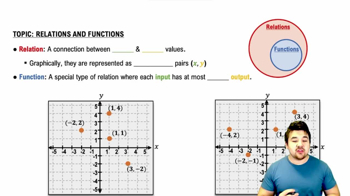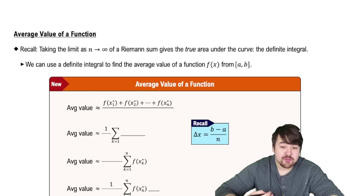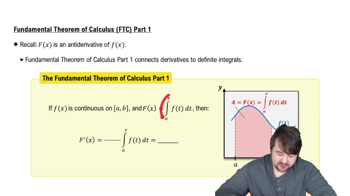Matching heights A stone is thrown with an initial velocity of 32 ft/s from the edge of a bridge that is 48 ft above the ground. The height of this stone above the ground t seconds after it is thrown is f(t) = −16t²+32t+48 . If a second stone is thrown from the ground, then its height above the ground after t seconds is given by g(t) = −16t²+v0t, where v0 is the initial velocity of the second stone. Determine the value of v0 such that both stones reach the same high point.
Table of contents
- 0. Functions7h 54m
- Introduction to Functions16m
- Piecewise Functions10m
- Properties of Functions9m
- Common Functions1h 8m
- Transformations5m
- Combining Functions27m
- Exponent rules32m
- Exponential Functions28m
- Logarithmic Functions24m
- Properties of Logarithms36m
- Exponential & Logarithmic Equations35m
- Introduction to Trigonometric Functions38m
- Graphs of Trigonometric Functions44m
- Trigonometric Identities47m
- Inverse Trigonometric Functions48m
- 1. Limits and Continuity2h 2m
- 2. Intro to Derivatives1h 33m
- 3. Techniques of Differentiation3h 18m
- 4. Applications of Derivatives2h 38m
- 5. Graphical Applications of Derivatives6h 2m
- 6. Derivatives of Inverse, Exponential, & Logarithmic Functions2h 37m
- 7. Antiderivatives & Indefinite Integrals1h 26m
- 8. Definite Integrals4h 44m
- 9. Graphical Applications of Integrals2h 27m
- 10. Physics Applications of Integrals 3h 16m
- 11. Integrals of Inverse, Exponential, & Logarithmic Functions2h 31m
- 12. Techniques of Integration7h 41m
- 13. Intro to Differential Equations2h 55m
- 14. Sequences & Series5h 36m
- 15. Power Series2h 19m
- 16. Parametric Equations & Polar Coordinates7h 58m
4. Applications of Derivatives
Motion Analysis
Problem 3.6.12a
Textbook Question
Airline travel The following figure shows the position function of an airliner on an out-and-back trip from Seattle to Minneapolis, where s = f(t) is the number of ground miles from Seattle t hours after take-off at 6:00 A.M. The plane returns to Seattle 8.5 hours later at 2:30 P.M. <IMAGE>
a. Calculate the average velocity of the airliner during the first 1.5 hours of the trip (0 ≤ t ≤ 1.5).
 Verified step by step guidance
Verified step by step guidance1
Identify the position function s = f(t), which represents the number of ground miles from Seattle at time t hours after take-off.
To find the average velocity over the interval [0, 1.5], use the formula for average velocity: \( \text{Average Velocity} = \frac{f(b) - f(a)}{b - a} \), where a and b are the endpoints of the time interval.
In this problem, a = 0 and b = 1.5, so substitute these values into the formula: \( \text{Average Velocity} = \frac{f(1.5) - f(0)}{1.5 - 0} \).
Determine the values of f(1.5) and f(0) from the position function or the given figure, which represent the distances at t = 1.5 hours and t = 0 hours, respectively.
Substitute the values of f(1.5) and f(0) into the average velocity formula to find the average velocity over the first 1.5 hours of the trip.
 Verified video answer for a similar problem:
Verified video answer for a similar problem:This video solution was recommended by our tutors as helpful for the problem above
Video duration:
5mPlay a video:
Was this helpful?
Key Concepts
Here are the essential concepts you must grasp in order to answer the question correctly.
Position Function
The position function, denoted as s = f(t), describes the location of an object over time. In this context, it represents the distance of the airliner from Seattle as a function of time since take-off. Understanding this function is crucial for analyzing the motion of the airliner and calculating various rates of change, such as velocity.
Recommended video:

Relations and Functions
Average Velocity
Average velocity is defined as the total displacement divided by the total time taken. For the airliner, it can be calculated by finding the change in position over the specified time interval (0 ≤ t ≤ 1.5 hours). This concept is essential for understanding how fast the plane is moving on average during the first part of its journey.
Recommended video:

Average Value of a Function
Calculus of Motion
The calculus of motion involves using derivatives and integrals to analyze the movement of objects. In this scenario, it helps in determining the average velocity and understanding the relationship between position, velocity, and time. Familiarity with these principles allows for a deeper insight into the dynamics of the airliner's trip.
Recommended video:

Fundamental Theorem of Calculus Part 1

 6:29m
6:29mWatch next
Master Derivatives Applied To Velocity with a bite sized video explanation from Patrick
Start learningRelated Videos
Related Practice
Textbook Question
